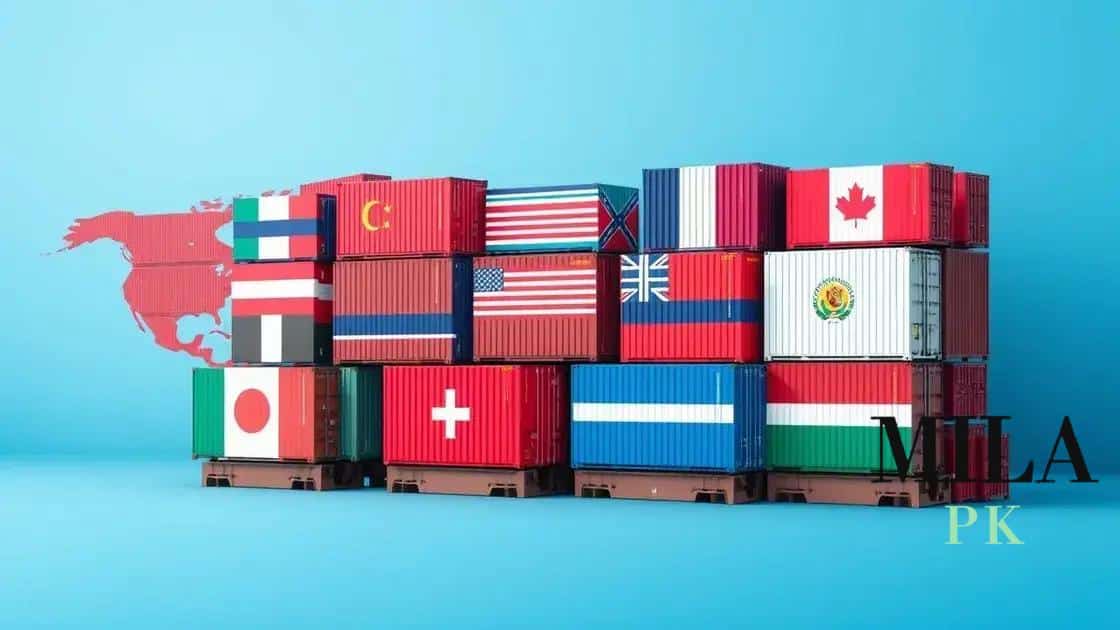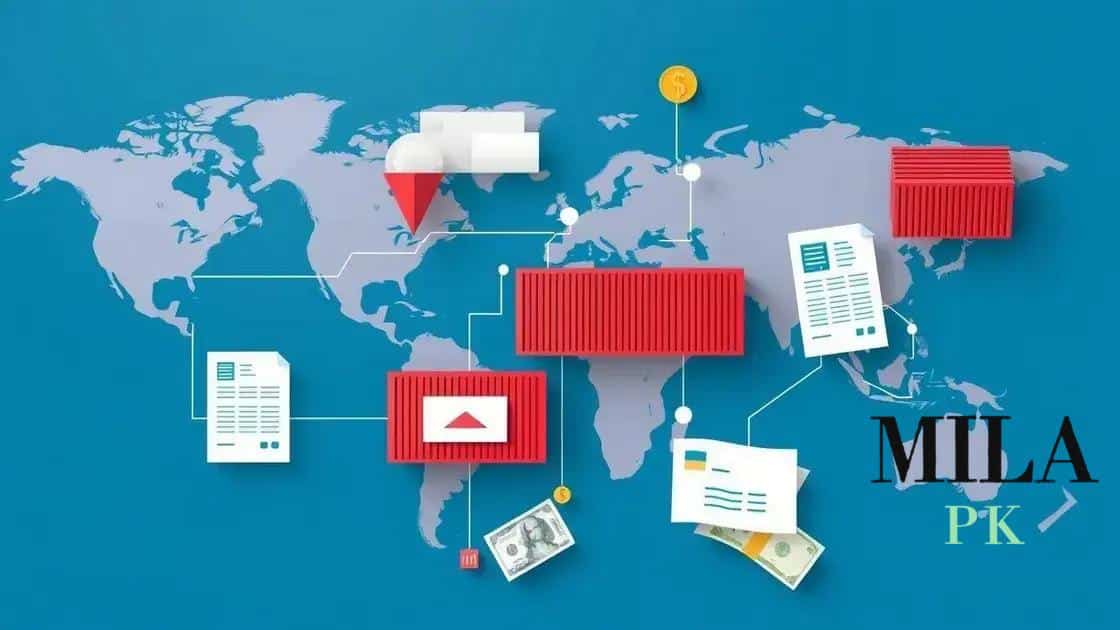US tariff legacy influences global trade response

US tariff legacy influences global trade response by disrupting international supply chains, altering trade relationships, and prompting retaliatory measures from affected countries.
US tariff legacy influences global trade response in profound ways. Have you ever wondered how past tariff decisions shape today’s trading environment? Let’s dive into their lasting effects.
Understanding the history of US tariffs
To truly understand the influence of tariffs in the United States, we need to take a step back in history. US tariffs have shaped economic relationships and policies for centuries. They are tools that governments use for various reasons, including protecting local industries, generating revenue, or responding to international trade disputes.
The Origins of Tariffs
In the early days of the American republic, tariffs played a crucial role. The first tariff act was established in 1789 to help fund the new government. As the nation grew, so did the complexities of its trade relations.
- Protection of budding industries
- Revenue generation for government expenses
- Addressing trade imbalances with foreign nations
Throughout the 19th century, tariffs were often a point of contention. They would sometimes ignite fierce debates between different regions of the country, especially between industrialized northern states and agrarian southern states.
Major Tariff Acts in History
Several significant tariff acts have left lasting impacts:
- The Tariff of 1828, also known as the “Tariff of Abominations,” raised duties significantly and led to discontent.
- The Tariff of 1861, meant to finance the Civil War, raised numerous rates, which later shifted post-war.
- The Smoot-Hawley Tariff of 1930 enacted massive tariff increases, resulting in retaliatory measures from other countries.
Each of these actions has influenced both domestic policies and international relations, underscoring the powerful role of tariffs in shaping economic landscapes.
The Role of Tariffs in the Modern Era
In the 21st century, the discussion around tariffs continues to evolve. With globalization, tariffs can trigger worldwide economic reactions. Countries find themselves negotiating trade agreements that involve reducing tariffs to foster better relations.
Understanding the historical context of US tariffs helps us navigate the complexities of today’s global trade. It’s fascinating how past decisions resonate in current economic strategies. By analyzing these historical events, we can glean insights into the trajectory of modern trade policies and their implications for the global economy.
Key effects of US tariffs on global trade

The key effects of US tariffs on global trade are profound and far-reaching. When the US imposes tariffs, it doesn’t just impact the domestic economy; the ripple effects can influence markets and economies around the globe. Understanding these effects is crucial for businesses and policymakers alike.
Disruption of Supply Chains
One of the immediate impacts of tariffs is the disruption of international supply chains. Companies often rely on imported goods and materials, and when tariffs increase, costs rise. This can lead businesses to change their sourcing strategies, which may affect everything from production timelines to pricing.
- Higher costs for raw materials
- Changes in supplier relationships
- Potential delays in product availability
Many businesses are forced to pass these costs onto consumers, which can lead to increased prices for everyday goods. This situation underscores how interconnected global supply chains are and how quickly they can be affected by policy decisions.
Altered Trade Relationships
Another major effect is the alteration of trade relationships. Countries that face increased tariffs may respond with their own tariffs, leading to a tit-for-tat scenario. This can strain diplomatic relations and create long-term barriers to trade.
These tensions can also lead countries to seek new trade partners or to strengthen existing agreements with allies. Such shifts can permanently alter trading patterns, reshaping the global economy.
Impact on Exports
The effects on exports can be equally significant. US companies may find it harder to sell their products abroad due to retaliatory tariffs. This can shrink market opportunities, especially for industries like agriculture and manufacturing, which rely heavily on foreign markets.
- Decline in competitiveness abroad
- Job losses in affected sectors
- Investments shifting to other countries
Ultimately, these changes can lead to economic instability both domestically and internationally, as businesses struggle to adapt to new trade environments.
Overall, the key effects of US tariffs on global trade demonstrate the complex interplay between national policies and international economics. The consequences extend beyond borders and can shape the future economic landscape.
Case studies of tariff impacts on industries
Exploring case studies of tariff impacts on industries reveals how tariffs can significantly affect various sectors. These real-world examples help illustrate the far-reaching consequences of policy decisions on different markets and economies.
Automotive Industry Case Study
The automotive industry has faced numerous tariff changes over the years. For instance, when the US increased tariffs on steel and aluminum in 2018, car manufacturers felt the pressure. Higher material costs meant that many automakers had to raise vehicle prices or cut their profit margins.
- Increased production costs
- Higher prices for consumers
- Shifts in supply chains, sourcing parts internationally
This situation led to several manufacturers moving production to countries with lower tariffs or sourcing aluminum from regions not impacted by the tariff increases.
Agricultural Sector Impact
The agricultural sector also shows significant effects due to tariffs, particularly with the trade tensions between the US and China. In this instance, tariffs imposed by China on American soybeans resulted in a steep decline in exports.
- Decline in income for farmers
- Market oversupply leading to price drops
- Increased reliance on domestic markets
American farmers had to adapt to these changes rapidly, with many seeking new markets or alternative crops to mitigate losses. The agricultural landscape shifted as a direct result of these tariff policies.
Textiles and Apparel Industry Examples
The textiles and apparel industry illustrates another aspect of tariff impacts. With new tariffs imposed on Chinese imports, many companies looked to relocate their manufacturing to other countries. This shift often aimed to avoid high tariffs and maintain competitive pricing.
However, transitioning operations posed challenges, including potential quality control issues and delays that impacted product availability.
This back-and-forth between tariff policies and sector adjustments demonstrates the complexities of international trade. Each industry has reacted differently, adapting to the constantly changing landscape of global trade relations and tariffs.
Responses from countries to US tariff policies
The responses from countries to US tariff policies highlight the complex dynamics of global trade. Nations around the world often react to US tariffs in ways that reflect their economic interests and diplomatic strategies.
Retaliatory Tariffs
One of the most common responses is the implementation of retaliatory tariffs. When the US imposes tariffs on imports, affected countries frequently respond by targeting American goods with their own tariffs. For example, after the US placed tariffs on steel and aluminum, countries like Canada and the EU imposed similar tariffs on a variety of US products.
- Impact on US exports
- Increased costs for American manufacturers
- Disruptions in established trade relationships
This action not only aims to protect domestic industries in the responding countries but also highlights the interconnected nature of global trade.
Negotiations and Trade Agreements
Countries also seek to negotiate new trade agreements or amend existing ones in response to US tariff actions. For instance, nations may pursue bilateral agreements to counterbalance the effects of tariffs. Many countries have worked to strengthen trade relationships with other partners to minimize dependence on US markets.
These negotiations often focus on reducing trade barriers and enhancing cooperation in various sectors, which can lead to new opportunities for trade and investment.
Domestic Economic Strategies
In some cases, countries respond to US tariffs by implementing domestic economic strategies. These measures may include subsidies for local industries or incentives to boost exports. By strengthening their own economies, nations aim to offset the negative impacts of tariffs.
Some countries have also focused on diversifying their economies to lessen reliance on specific imports or exports, such as shifting agricultural production or exploring alternative markets.
Overall, the responses from countries to US tariff policies illustrate a complex web of interactions where economic and political factors collide. Through retaliatory measures, negotiations, and domestic strategies, nations seek to navigate the challenges posed by tariffs and find pathways to stabilize their economies.
Future trends in global trade relationships
The future trends in global trade relationships shape how countries interact economically and politically. As the world becomes more interconnected, several key trends are emerging that will influence global trade.
Increased Digital Trade
One significant trend is the rise of digital trade. As e-commerce grows, countries are adapting their trade policies to accommodate online transactions. This includes streamlining customs processes for digital goods and services.
- Growth in cross-border e-commerce
- Emergence of digital tariffs on services
- Improved online payment systems
These developments enable businesses to reach new markets and consumers to access products from around the globe with greater ease.
Focus on Sustainability
Sustainability is becoming a major influencing factor in trade policies. Many countries are implementing regulations that require sustainable practices in production and sourcing. Businesses are increasingly held to standards that consider their environmental impact.
Shifts in consumer preferences toward sustainable products lead companies to rethink their supply chains to comply with these regulations.
Shifting Geopolitical Dynamics
Geopolitical changes also affect global trade relationships. Rising powers may challenge established trade norms, leading to new alliances and trade agreements. For example, countries are forming partnerships that align with their economic or strategic interests.
These changes can lead to greater regional cooperation or economic blocs as nations seek to strengthen their positions in the global market.
Technological Advancements
Technological innovations, such as automation and artificial intelligence, are altering how goods are produced and traded. Businesses adopting these technologies can improve efficiency and reduce costs. The integration of technology in logistics and supply chains leads to better tracking and transparency in products and services.
As the global trade landscape evolves, the emphasis on these trends will shape future negotiations, agreements, and the overall direction of international trade.
Conclusion: The landscape of global trade is continually evolving, influenced by tariff policies, international responses, and emerging trends. Understanding how these factors interact helps businesses and policymakers navigate future challenges. As we look ahead, digital trade, a focus on sustainability, shifting geopolitical dynamics, and technological advancements will shape the future of global trade relationships. Staying informed about these trends is crucial for adapting and thriving in a complex economic world.
FAQ – Frequently Asked Questions about US Tariffs and Global Trade
What are tariffs and why are they used?
Tariffs are taxes imposed on imported goods to protect domestic industries, generate revenue, or respond to trade disputes.
How do tariffs affect global trade relationships?
Tariffs can disrupt trade balances, leading to retaliatory measures from other countries and altering trade dynamics.
What role does technology play in shaping future trade?
Technological advancements enhance efficiency in logistics and production, impacting how countries engage in trade.
What are the potential responses from countries to US tariff policies?
Countries may implement retaliatory tariffs, negotiate new trade agreements, or adjust their domestic economic strategies to mitigate impacts.





